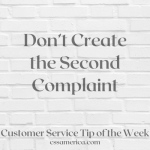We all have to deal with some crazy customers, at times. They might be loud or sad. Flighty or mad. They may have unrealistic expectations or think it’s OK to skip past people in line because their need must be more important than the others. Some are rude, some are disrespectful, and some just flat don’t know how to communicate politely or professionally. So, it’s understandable why our emotions are triggered, and we can reflect their ornery nature if we’re not careful.
One way to deal with the ornery customer is to have an open mind. I’m not suggesting that we capitulate to their concern.
Rather, we need our mind to be open to finding new ways to navigate the conversation. New ways to get to resolution. New ways to close a conversation.
I’m not talking technique, per se, about how to handle the angry customer. We’ve dealt with that many times in these tips. Instead, I’m talking about how we handle ourselves intellectually in a conversation that has the potential to go down the tubes emotionally.
Openness is about allowing the new, the creative, the different, the atypical path forward. What people can you involve in the conversation or direct the customer to in order to move forward? What process can you begin that can make the conversation more productive? Is there an action you can take in front of the customer – right then – to show that you’re in it with them? Is there an action you can have them do at that moment so they feel like progress has started (and to distract them a little)? Is there a way to end the conversation with your promise of a follow-up call, e-mail, or text by the end of the day?
When you’re dealing with the ornery customer, you have to deal with the emotions. But if we keep an open mind about the possible solutions for the situation, maybe that emotion won’t dominate our reaction. Maybe we can more quickly close the conversation and move to the next step.
Keep an open mind with the ornery customer.
Signup for FREE Tips! Contact Us More Resources for You Visit Our Home Page
















 Most of our customer service tips offer advice and guidance. But advice and guidance is useless if the individual receiving it is not willing to listen, learn the theory behind it, and try to apply what they’ve heard or learned.
Most of our customer service tips offer advice and guidance. But advice and guidance is useless if the individual receiving it is not willing to listen, learn the theory behind it, and try to apply what they’ve heard or learned.






